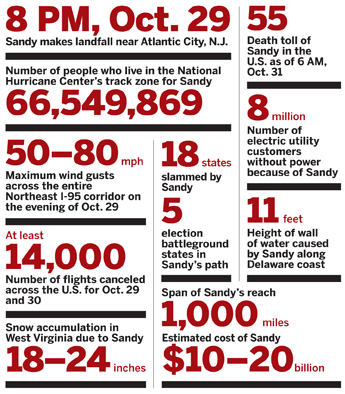Advertisement
Grab your lab coat. Let's get started
Welcome!
Welcome!
Create an account below to get 6 C&EN articles per month, receive newsletters and more - all free.
It seems this is your first time logging in online. Please enter the following information to continue.
As an ACS member you automatically get access to this site. All we need is few more details to create your reading experience.
Not you? Sign in with a different account.
Not you? Sign in with a different account.
ERROR 1
ERROR 1
ERROR 2
ERROR 2
ERROR 2
ERROR 2
ERROR 2
Password and Confirm password must match.
If you have an ACS member number, please enter it here so we can link this account to your membership. (optional)
ERROR 2
ACS values your privacy. By submitting your information, you are gaining access to C&EN and subscribing to our weekly newsletter. We use the information you provide to make your reading experience better, and we will never sell your data to third party members.
Environment
Superstorm Sandy
by A. Maureen Rouhi
November 1, 2012
| A version of this story appeared in
Volume 90, Issue 45

Hurricane Sandy started pummeling Washington, D.C., at around 3 PM on Monday, Oct. 29, with wind gusts of up to 60 mph. From my cursory view of the streets in downtown Washington, before daybreak on Oct. 30, just a couple of blocks from the White House, it appears the capital has been spared the worst. As I write on Oct. 30, the full impact of Sandy has yet to play out.
The federal government was closed on Oct. 29 and 30, as was the American Chemical Society. At C&EN, we mobilized to get a core crew safely inside ACS headquarters ahead of the storm. The rest of the Washington staff involved with this issue worked from home as long as they had power. Most of our colleagues based in Massachusetts, New Jersey, New York, Pennsylvania, and Rhode Island were relatively unscathed. Two of our colleagues, however, suffered more than most. A tree fell on, and split open, the garage roof of a Washington-based C&EN staffer. And a New Jersey-based staffer and his family evacuated their home on Staten Island in time to flee the rising waters, which reached 14 feet at one point.
We will remember Superstorm Sandy for a long time, as we still remember the Snowmageddon of 2010.
Related Story: Hurricane Sandy Slams East Coast
Disaster: Massive storm brings flooding, power outages but the chemical enterprise escapes largely unscathed
Views expressed on this page are those of the author and not necessarily those of ACS.




Join the conversation
Contact the reporter
Submit a Letter to the Editor for publication
Engage with us on Twitter